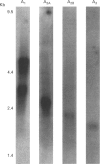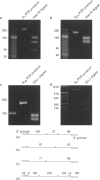Abstract
1. A degree of ambiguity and uncertainty exists concerning the distribution of mRNAs encoding the four cloned adenosine receptors. In order to consolidate and extent current understanding in this area, the expression of the adenosine receptors has been examined in the rat by use of in situ hybridisation and the reverse transcription-polymerase chain reaction (RT-PCR). 2. In accordance with earlier studies, in situ hybridisation revealed that the adenosine A1 receptor was widely expressed in the brain, whereas A2A receptor mRNA was restricted to the striatum, nucleus accumbens and olfactory tubercle. In addition, A1 receptor mRNA was detected in large striatal cholinergic interneurones, 26% of these neurones were also found to express the A2A receptor gene. Central levels of mRNAs encoding adenosine A2B and A3 receptors were, however, below the detection limits of in situ hybridisation. 3. The more sensitive technique of RT-PCR was then employed to investigate the distribution of adenosine receptor mRNAs in the central nervous system (CNS) and a wide range of peripheral tissues. As a result, many novel sites of adenosine receptor gene expression were identified. A1 receptor expression has now been found in the heart, aorta, liver, kidney, eye and bladder. These observations are largely consistent with previous functional data. A2A receptor mRNA was detected in all brain regions tested, demonstrating that expression of this receptor is not restricted to the basal ganglia. In the periphery A2A receptor mRNA was also found to be more widely distributed than generally recognised. The ubiquitous distribution of the A2B receptor is shown for the first time, A2B mRNA was detected at various levels in all rat tissues studied. Expression of the gene encoding the adenosine A3 receptor was also found to be widespread in the rat, message detected throughout the CNS and in many peripheral tissues. This pattern of expression is similar to that observed in man and sheep, which had previously been perceived to possess distinct patterns of A3 receptor gene expression in comparison to the rat. 4. In summary, this work has comprehensively studied the expression of all the cloned adenosine receptors in the rat, and in so doing, resolves some of the uncertainty over where these receptors might act to control physiological processes mediated by adenosine.
Full text
PDF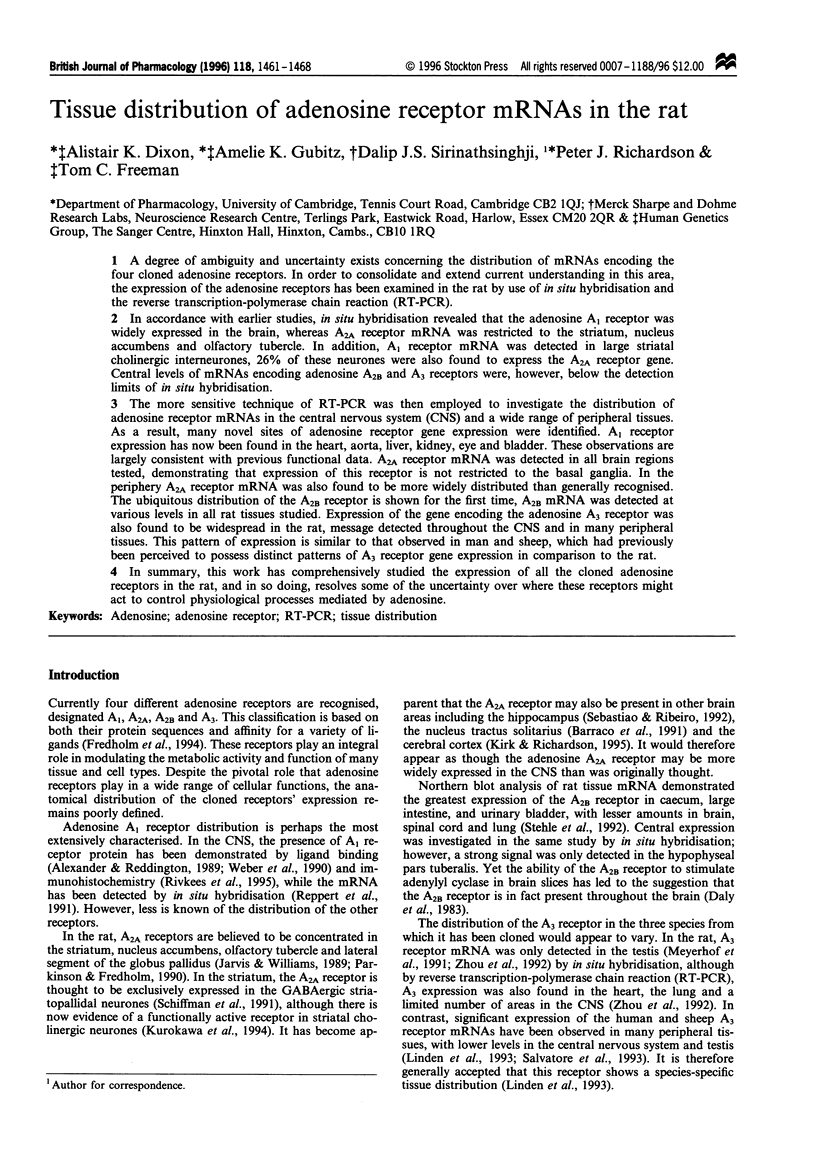
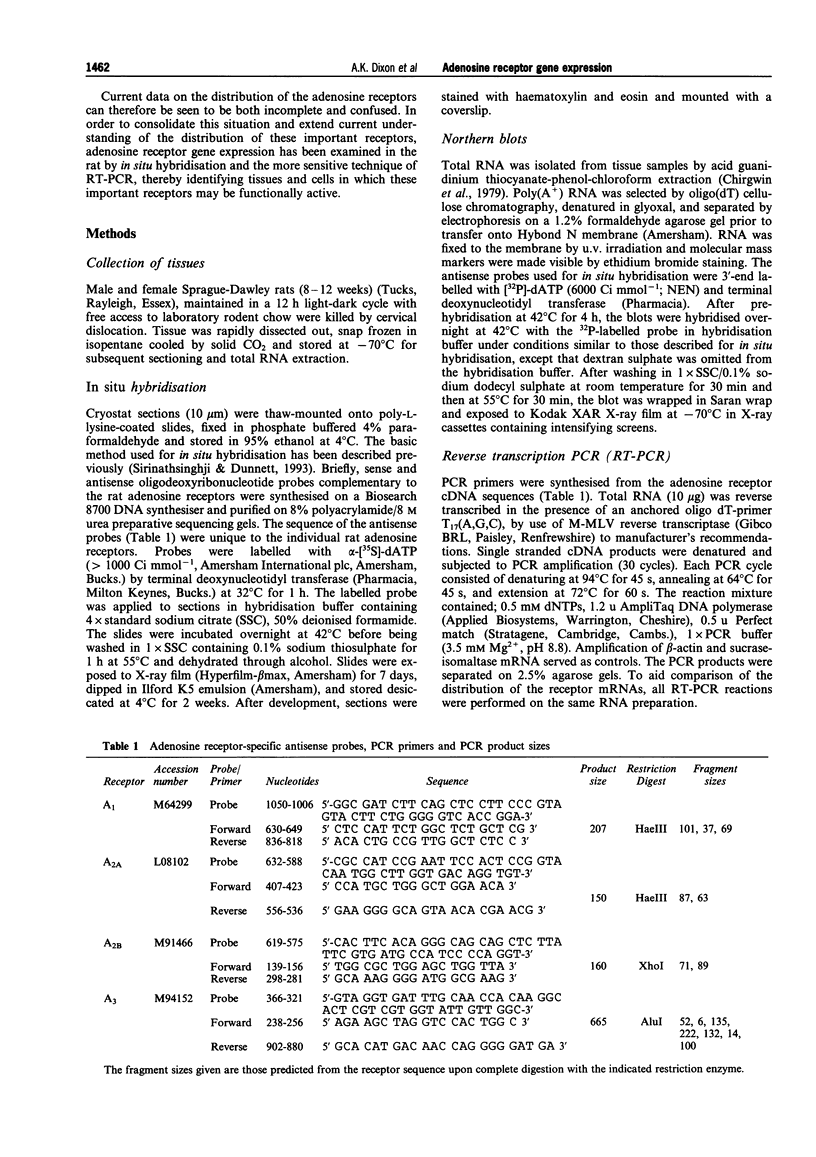
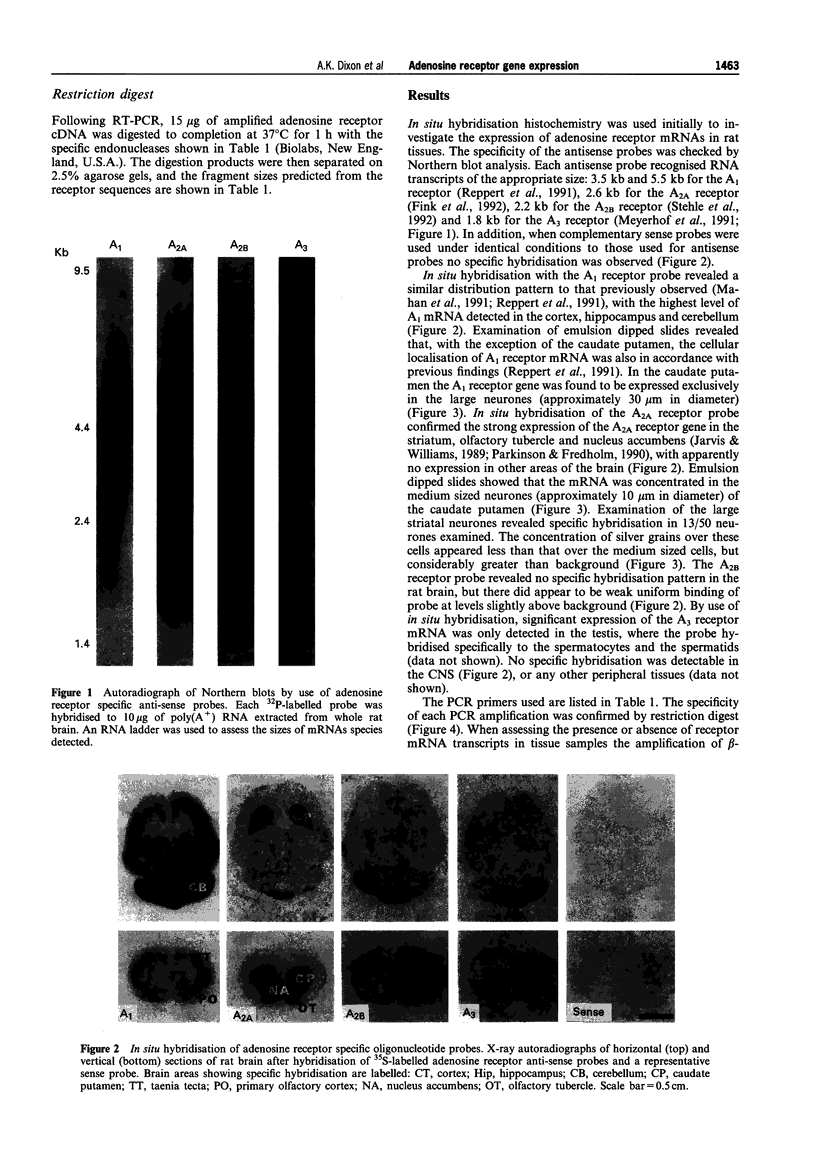
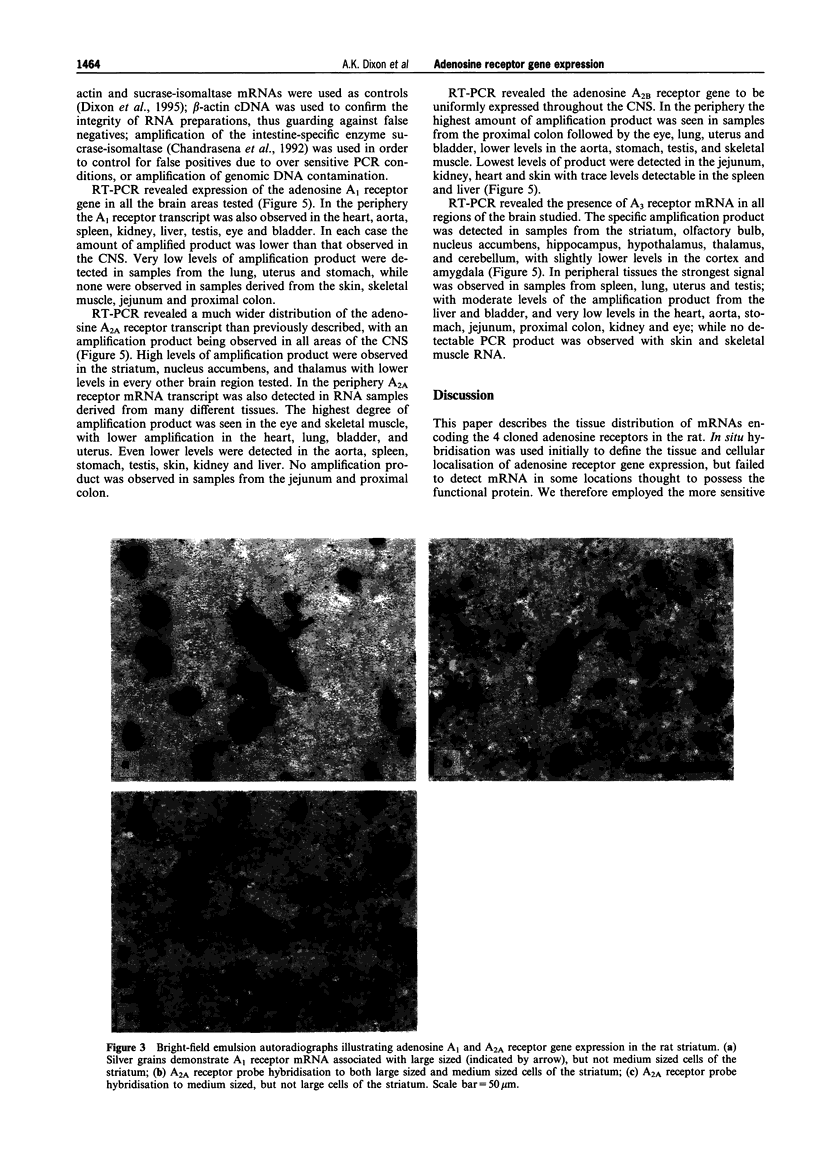
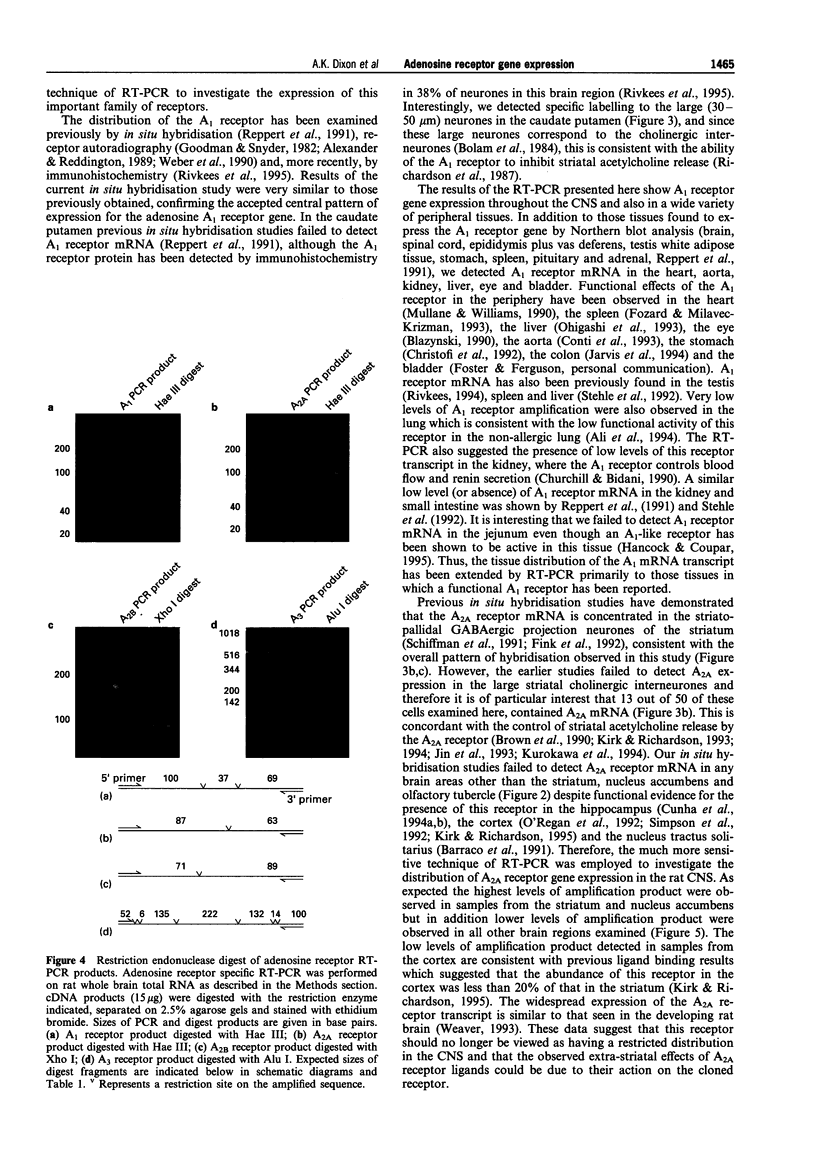
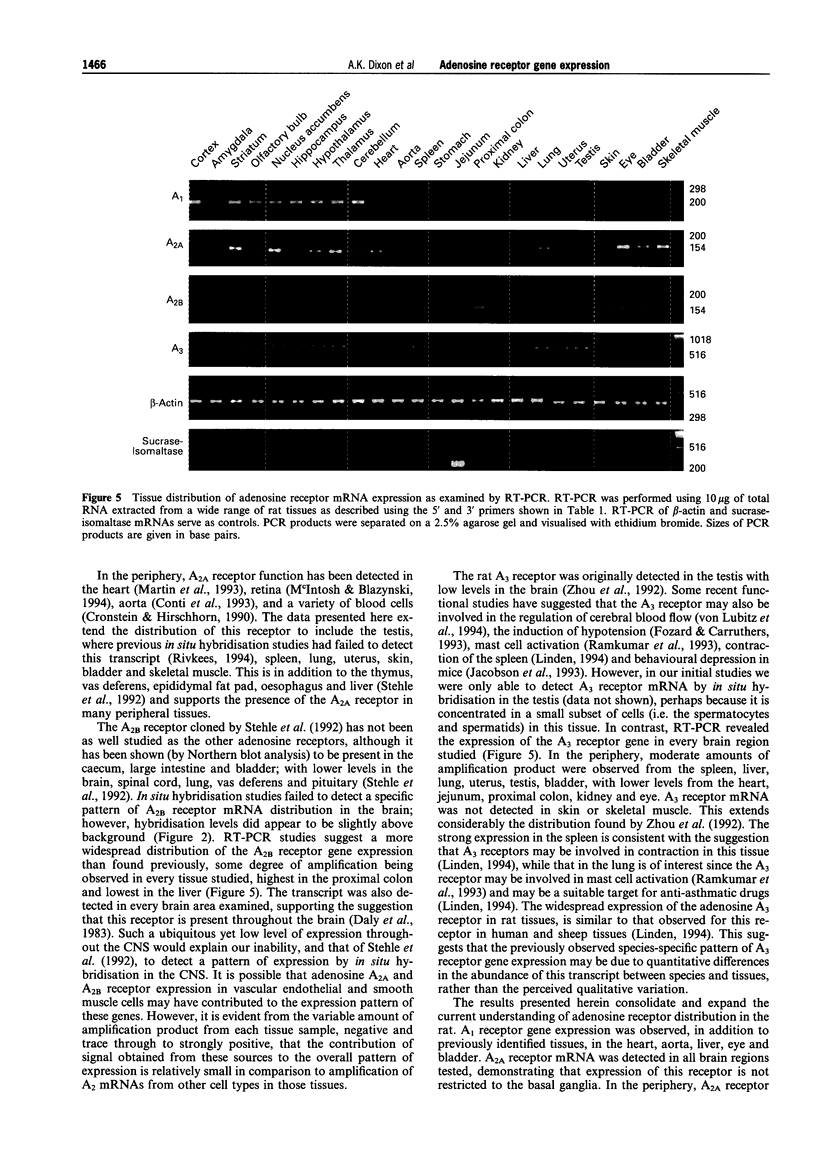
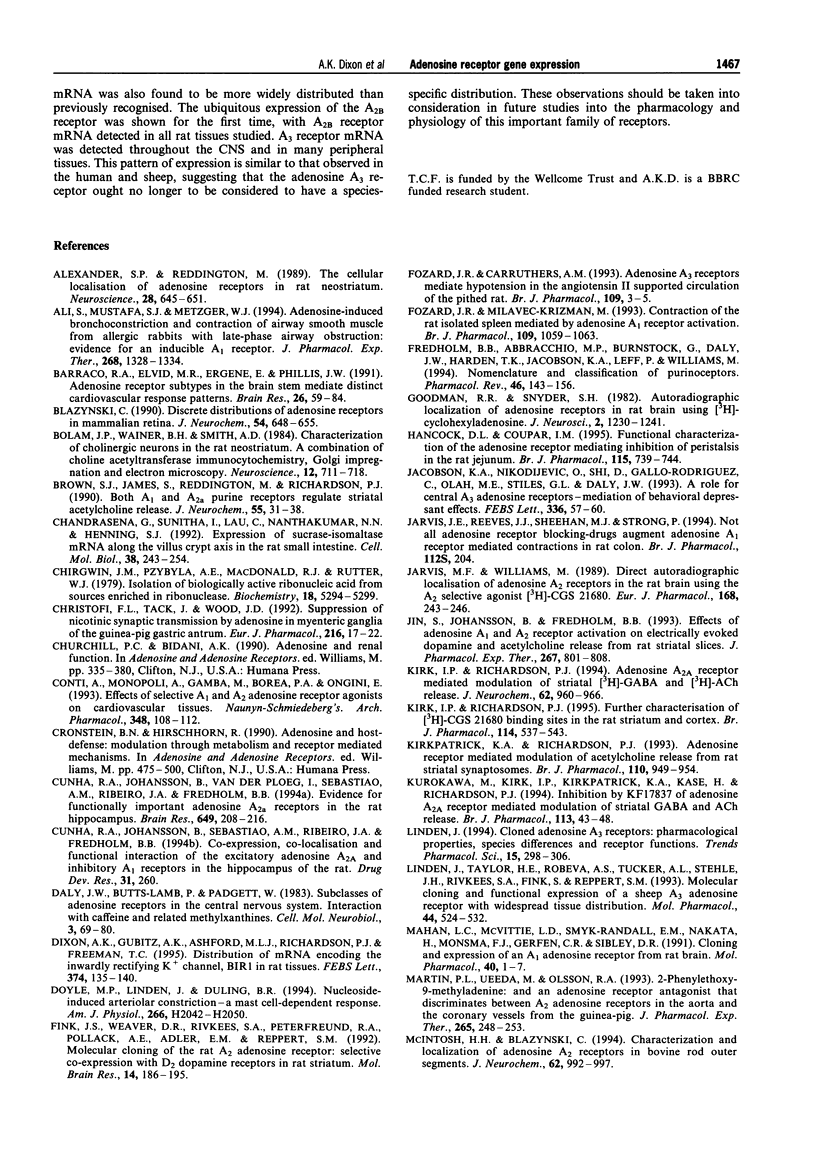
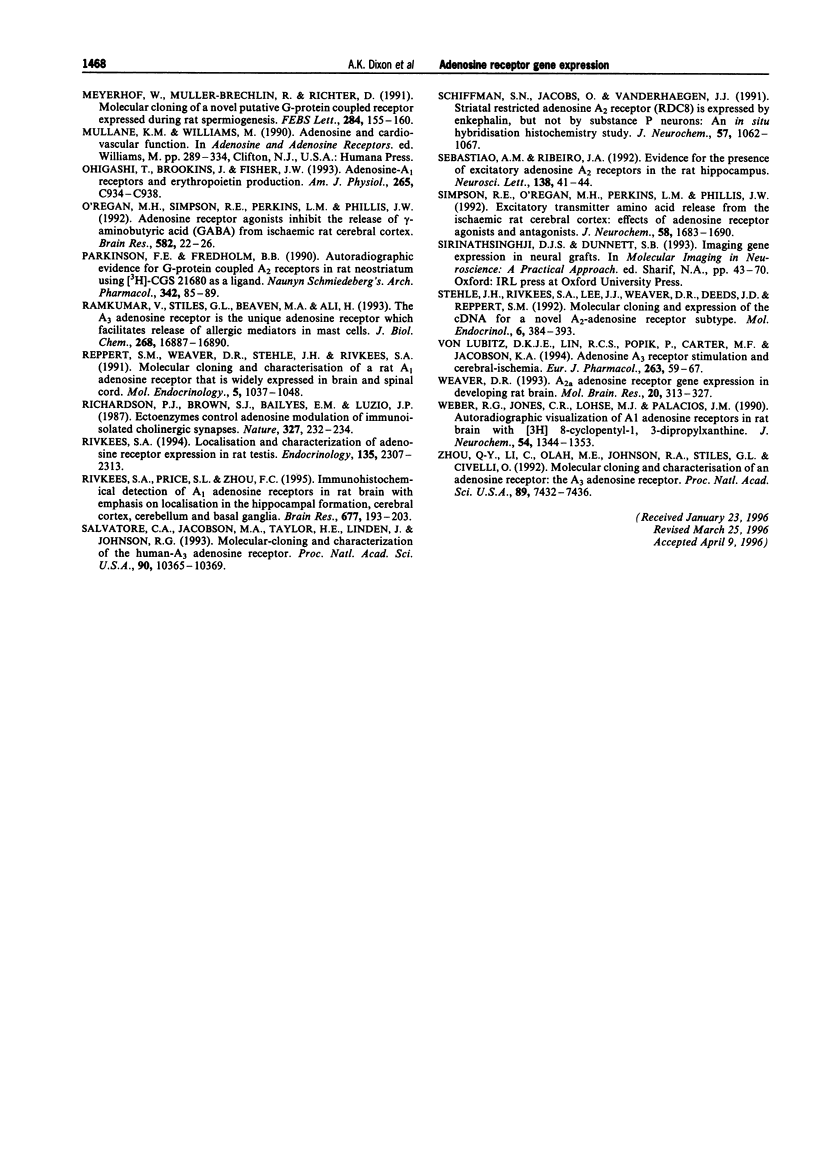
Images in this article
Selected References
These references are in PubMed. This may not be the complete list of references from this article.
- Alexander S. P., Reddington M. The cellular localization of adenosine receptors in rat neostriatum. Neuroscience. 1989;28(3):645–651. doi: 10.1016/0306-4522(89)90011-0. [DOI] [PubMed] [Google Scholar]
- Ali S., Mustafa S. J., Metzger W. J. Adenosine-induced bronchoconstriction and contraction of airway smooth muscle from allergic rabbits with late-phase airway obstruction: evidence for an inducible adenosine A1 receptor. J Pharmacol Exp Ther. 1994 Mar;268(3):1328–1334. [PubMed] [Google Scholar]
- Barraco R. A., el-Ridi M. R., Ergene E., Phillis J. W. Adenosine receptor subtypes in the brainstem mediate distinct cardiovascular response patterns. Brain Res Bull. 1991 Jan;26(1):59–84. doi: 10.1016/0361-9230(91)90192-m. [DOI] [PubMed] [Google Scholar]
- Blazynski C. Discrete distributions of adenosine receptors in mammalian retina. J Neurochem. 1990 Feb;54(2):648–655. doi: 10.1111/j.1471-4159.1990.tb01920.x. [DOI] [PubMed] [Google Scholar]
- Bolam J. P., Wainer B. H., Smith A. D. Characterization of cholinergic neurons in the rat neostriatum. A combination of choline acetyltransferase immunocytochemistry, Golgi-impregnation and electron microscopy. Neuroscience. 1984 Jul;12(3):711–718. doi: 10.1016/0306-4522(84)90165-9. [DOI] [PubMed] [Google Scholar]
- Brown S. J., James S., Reddington M., Richardson P. J. Both A1 and A2a purine receptors regulate striatal acetylcholine release. J Neurochem. 1990 Jul;55(1):31–38. doi: 10.1111/j.1471-4159.1990.tb08817.x. [DOI] [PubMed] [Google Scholar]
- Chandrasena G., Sunitha I., Lau C., Nanthakumar N. N., Henning S. J. Expression of sucrase-isomaltase mRNA along the villus-crypt axis in the rat small intestine. Cell Mol Biol. 1992 May;38(3):243–254. [PubMed] [Google Scholar]
- Chirgwin J. M., Przybyla A. E., MacDonald R. J., Rutter W. J. Isolation of biologically active ribonucleic acid from sources enriched in ribonuclease. Biochemistry. 1979 Nov 27;18(24):5294–5299. doi: 10.1021/bi00591a005. [DOI] [PubMed] [Google Scholar]
- Christofi F. L., Tack J., Wood J. D. Suppression of nicotinic synaptic transmission by adenosine in myenteric ganglia of the guinea-pig gastric antrum. Eur J Pharmacol. 1992 May 27;216(1):17–22. doi: 10.1016/0014-2999(92)90203-g. [DOI] [PubMed] [Google Scholar]
- Conti A., Monopoli A., Gamba M., Borea P. A., Ongini E. Effects of selective A1 and A2 adenosine receptor agonists on cardiovascular tissues. Naunyn Schmiedebergs Arch Pharmacol. 1993 Jul;348(1):108–112. doi: 10.1007/BF00168545. [DOI] [PubMed] [Google Scholar]
- Cunha R. A., Johansson B., van der Ploeg I., Sebastião A. M., Ribeiro J. A., Fredholm B. B. Evidence for functionally important adenosine A2a receptors in the rat hippocampus. Brain Res. 1994 Jun 27;649(1-2):208–216. doi: 10.1016/0006-8993(94)91066-9. [DOI] [PubMed] [Google Scholar]
- Daly J. W., Butts-Lamb P., Padgett W. Subclasses of adenosine receptors in the central nervous system: interaction with caffeine and related methylxanthines. Cell Mol Neurobiol. 1983 Mar;3(1):69–80. doi: 10.1007/BF00734999. [DOI] [PMC free article] [PubMed] [Google Scholar]
- Dixon A. K., Gubitz A. K., Ashford M. L., Richardson P. J., Freeman T. C. Distribution of mRNA encoding the inwardly rectifying K+ channel, BIR1 in rat tissues. FEBS Lett. 1995 Oct 23;374(1):135–140. doi: 10.1016/0014-5793(95)01091-r. [DOI] [PubMed] [Google Scholar]
- Doyle M. P., Linden J., Duling B. R. Nucleoside-induced arteriolar constriction: a mast cell-dependent response. Am J Physiol. 1994 May;266(5 Pt 2):H2042–H2050. doi: 10.1152/ajpheart.1994.266.5.H2042. [DOI] [PubMed] [Google Scholar]
- Fink J. S., Weaver D. R., Rivkees S. A., Peterfreund R. A., Pollack A. E., Adler E. M., Reppert S. M. Molecular cloning of the rat A2 adenosine receptor: selective co-expression with D2 dopamine receptors in rat striatum. Brain Res Mol Brain Res. 1992 Jul;14(3):186–195. doi: 10.1016/0169-328x(92)90173-9. [DOI] [PubMed] [Google Scholar]
- Fozard J. R., Carruthers A. M. Adenosine A3 receptors mediate hypotension in the angiotensin II-supported circulation of the pithed rat. Br J Pharmacol. 1993 May;109(1):3–5. doi: 10.1111/j.1476-5381.1993.tb13522.x. [DOI] [PMC free article] [PubMed] [Google Scholar]
- Fozard J. R., Milavec-Krizman M. Contraction of the rat isolated spleen mediated by adenosine A1 receptor activation. Br J Pharmacol. 1993 Aug;109(4):1059–1063. doi: 10.1111/j.1476-5381.1993.tb13729.x. [DOI] [PMC free article] [PubMed] [Google Scholar]
- Fredholm B. B., Abbracchio M. P., Burnstock G., Daly J. W., Harden T. K., Jacobson K. A., Leff P., Williams M. Nomenclature and classification of purinoceptors. Pharmacol Rev. 1994 Jun;46(2):143–156. [PMC free article] [PubMed] [Google Scholar]
- Goodman R. R., Synder S. H. Autoradiographic localization of adenosine receptors in rat brain using [3H]cyclohexyladenosine. J Neurosci. 1982 Sep;2(9):1230–1241. doi: 10.1523/JNEUROSCI.02-09-01230.1982. [DOI] [PMC free article] [PubMed] [Google Scholar]
- Hancock D. L., Coupar I. M. Functional characterization of the adenosine receptor mediating inhibition of peristalsis in the rat jejunum. Br J Pharmacol. 1995 Jul;115(5):739–744. doi: 10.1111/j.1476-5381.1995.tb14995.x. [DOI] [PMC free article] [PubMed] [Google Scholar]
- Jacobson K. A., Nikodijević O., Shi D., Gallo-Rodriguez C., Olah M. E., Stiles G. L., Daly J. W. A role for central A3-adenosine receptors. Mediation of behavioral depressant effects. FEBS Lett. 1993 Dec 20;336(1):57–60. doi: 10.1016/0014-5793(93)81608-3. [DOI] [PMC free article] [PubMed] [Google Scholar]
- Jarvis M. F., Williams M. Direct autoradiographic localization of adenosine A2 receptors in the rat brain using the A2-selective agonist, [3H]CGS 21680. Eur J Pharmacol. 1989 Sep 13;168(2):243–246. doi: 10.1016/0014-2999(89)90571-2. [DOI] [PubMed] [Google Scholar]
- Jin S., Johansson B., Fredholm B. B. Effects of adenosine A1 and A2 receptor activation on electrically evoked dopamine and acetylcholine release from rat striatal slices. J Pharmacol Exp Ther. 1993 Nov;267(2):801–808. [PubMed] [Google Scholar]
- Kirk I. P., Richardson P. J. Adenosine A2a receptor-mediated modulation of striatal [3H]GABA and [3H]acetylcholine release. J Neurochem. 1994 Mar;62(3):960–966. doi: 10.1046/j.1471-4159.1994.62030960.x. [DOI] [PubMed] [Google Scholar]
- Kirk I. P., Richardson P. J. Further characterization of [3H]-CGS 21680 binding sites in the rat striatum and cortex. Br J Pharmacol. 1995 Jan;114(2):537–543. doi: 10.1111/j.1476-5381.1995.tb13260.x. [DOI] [PMC free article] [PubMed] [Google Scholar]
- Kirkpatrick K. A., Richardson P. J. Adenosine receptor-mediated modulation of acetylcholine release from rat striatal synaptosomes. Br J Pharmacol. 1993 Nov;110(3):949–954. doi: 10.1111/j.1476-5381.1993.tb13905.x. [DOI] [PMC free article] [PubMed] [Google Scholar]
- Kurokawa M., Kirk I. P., Kirkpatrick K. A., Kase H., Richardson P. J. Inhibition by KF17837 of adenosine A2A receptor-mediated modulation of striatal GABA and ACh release. Br J Pharmacol. 1994 Sep;113(1):43–48. doi: 10.1111/j.1476-5381.1994.tb16171.x. [DOI] [PMC free article] [PubMed] [Google Scholar]
- Linden J. Cloned adenosine A3 receptors: pharmacological properties, species differences and receptor functions. Trends Pharmacol Sci. 1994 Aug;15(8):298–306. doi: 10.1016/0165-6147(94)90011-6. [DOI] [PubMed] [Google Scholar]
- Linden J., Taylor H. E., Robeva A. S., Tucker A. L., Stehle J. H., Rivkees S. A., Fink J. S., Reppert S. M. Molecular cloning and functional expression of a sheep A3 adenosine receptor with widespread tissue distribution. Mol Pharmacol. 1993 Sep;44(3):524–532. [PubMed] [Google Scholar]
- Mahan L. C., McVittie L. D., Smyk-Randall E. M., Nakata H., Monsma F. J., Jr, Gerfen C. R., Sibley D. R. Cloning and expression of an A1 adenosine receptor from rat brain. Mol Pharmacol. 1991 Jul;40(1):1–7. [PubMed] [Google Scholar]
- Martin P. L., Ueeda M., Olsson R. A. 2-Phenylethoxy-9-methyladenine: an adenosine receptor antagonist that discriminates between A2 adenosine receptors in the aorta and the coronary vessels from the guinea pig. J Pharmacol Exp Ther. 1993 Apr;265(1):248–253. [PubMed] [Google Scholar]
- McIntosh H. H., Blazynski C. Characterization and localization of adenosine A2 receptors in bovine rod outer segments. J Neurochem. 1994 Mar;62(3):992–997. doi: 10.1046/j.1471-4159.1994.62030992.x. [DOI] [PubMed] [Google Scholar]
- Meyerhof W., Müller-Brechlin R., Richter D. Molecular cloning of a novel putative G-protein coupled receptor expressed during rat spermiogenesis. FEBS Lett. 1991 Jun 24;284(2):155–160. doi: 10.1016/0014-5793(91)80674-r. [DOI] [PubMed] [Google Scholar]
- O'Regan M. H., Simpson R. E., Perkins L. M., Phillis J. W. Adenosine receptor agonists inhibit the release of gamma-aminobutyric acid (GABA) from the ischemic rat cerebral cortex. Brain Res. 1992 Jun 5;582(1):22–26. doi: 10.1016/0006-8993(92)90312-w. [DOI] [PubMed] [Google Scholar]
- Ohigashi T., Brookins J., Fisher J. W. Adenosine A1 receptors and erythropoietin production. Am J Physiol. 1993 Oct;265(4 Pt 1):C934–C938. doi: 10.1152/ajpcell.1993.265.4.C934. [DOI] [PubMed] [Google Scholar]
- Parkinson F. E., Fredholm B. B. Autoradiographic evidence for G-protein coupled A2-receptors in rat neostriatum using [3H]-CGS 21680 as a ligand. Naunyn Schmiedebergs Arch Pharmacol. 1990 Jul;342(1):85–89. doi: 10.1007/BF00178977. [DOI] [PubMed] [Google Scholar]
- Ramkumar V., Stiles G. L., Beaven M. A., Ali H. The A3 adenosine receptor is the unique adenosine receptor which facilitates release of allergic mediators in mast cells. J Biol Chem. 1993 Aug 15;268(23):16887–16890. [PubMed] [Google Scholar]
- Reppert S. M., Weaver D. R., Stehle J. H., Rivkees S. A. Molecular cloning and characterization of a rat A1-adenosine receptor that is widely expressed in brain and spinal cord. Mol Endocrinol. 1991 Aug;5(8):1037–1048. doi: 10.1210/mend-5-8-1037. [DOI] [PubMed] [Google Scholar]
- Richardson P. J., Brown S. J., Bailyes E. M., Luzio J. P. Ectoenzymes control adenosine modulation of immunoisolated cholinergic synapses. Nature. 1987 May 21;327(6119):232–234. doi: 10.1038/327232a0. [DOI] [PubMed] [Google Scholar]
- Rivkees S. A. Localization and characterization of adenosine receptor expression in rat testis. Endocrinology. 1994 Dec;135(6):2307–2313. doi: 10.1210/endo.135.6.7988413. [DOI] [PubMed] [Google Scholar]
- Rivkees S. A., Price S. L., Zhou F. C. Immunohistochemical detection of A1 adenosine receptors in rat brain with emphasis on localization in the hippocampal formation, cerebral cortex, cerebellum, and basal ganglia. Brain Res. 1995 Apr 24;677(2):193–203. doi: 10.1016/0006-8993(95)00062-u. [DOI] [PubMed] [Google Scholar]
- Salvatore C. A., Jacobson M. A., Taylor H. E., Linden J., Johnson R. G. Molecular cloning and characterization of the human A3 adenosine receptor. Proc Natl Acad Sci U S A. 1993 Nov 1;90(21):10365–10369. doi: 10.1073/pnas.90.21.10365. [DOI] [PMC free article] [PubMed] [Google Scholar]
- Schiffmann S. N., Jacobs O., Vanderhaeghen J. J. Striatal restricted adenosine A2 receptor (RDC8) is expressed by enkephalin but not by substance P neurons: an in situ hybridization histochemistry study. J Neurochem. 1991 Sep;57(3):1062–1067. doi: 10.1111/j.1471-4159.1991.tb08257.x. [DOI] [PubMed] [Google Scholar]
- Sebastião A. M., Ribeiro J. A. Evidence for the presence of excitatory A2 adenosine receptors in the rat hippocampus. Neurosci Lett. 1992 Apr 13;138(1):41–44. doi: 10.1016/0304-3940(92)90467-l. [DOI] [PubMed] [Google Scholar]
- Simpson R. E., O'Regan M. H., Perkins L. M., Phillis J. W. Excitatory transmitter amino acid release from the ischemic rat cerebral cortex: effects of adenosine receptor agonists and antagonists. J Neurochem. 1992 May;58(5):1683–1690. doi: 10.1111/j.1471-4159.1992.tb10041.x. [DOI] [PubMed] [Google Scholar]
- Stehle J. H., Rivkees S. A., Lee J. J., Weaver D. R., Deeds J. D., Reppert S. M. Molecular cloning and expression of the cDNA for a novel A2-adenosine receptor subtype. Mol Endocrinol. 1992 Mar;6(3):384–393. doi: 10.1210/mend.6.3.1584214. [DOI] [PubMed] [Google Scholar]
- Von Lubitz D. K., Lin R. C., Popik P., Carter M. F., Jacobson K. A. Adenosine A3 receptor stimulation and cerebral ischemia. Eur J Pharmacol. 1994 Sep 22;263(1-2):59–67. doi: 10.1016/0014-2999(94)90523-1. [DOI] [PMC free article] [PubMed] [Google Scholar]
- Weaver D. R. A2a adenosine receptor gene expression in developing rat brain. Brain Res Mol Brain Res. 1993 Dec;20(4):313–327. doi: 10.1016/0169-328x(93)90058-w. [DOI] [PubMed] [Google Scholar]
- Weber R. G., Jones C. R., Lohse M. J., Palacios J. M. Autoradiographic visualization of A1 adenosine receptors in rat brain with [3H]8-cyclopentyl-1,3-dipropylxanthine. J Neurochem. 1990 Apr;54(4):1344–1353. doi: 10.1111/j.1471-4159.1990.tb01968.x. [DOI] [PubMed] [Google Scholar]
- Zhou Q. Y., Li C., Olah M. E., Johnson R. A., Stiles G. L., Civelli O. Molecular cloning and characterization of an adenosine receptor: the A3 adenosine receptor. Proc Natl Acad Sci U S A. 1992 Aug 15;89(16):7432–7436. doi: 10.1073/pnas.89.16.7432. [DOI] [PMC free article] [PubMed] [Google Scholar]



